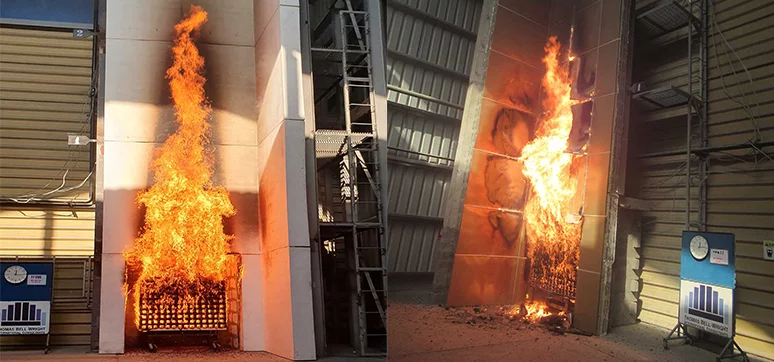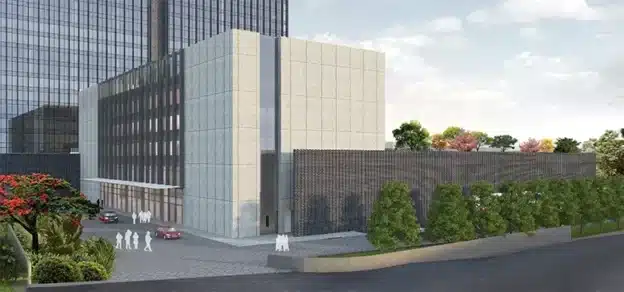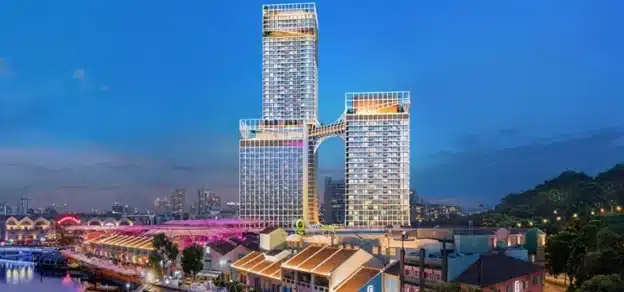The Grenfell Tragedy in 2017 which shook the United Kingdom and the world brought the spotlight on the British standard for fire performance of external cladding systems – BS 8414. This test method has been ported to standards in countries such as Australia, Malaysia, and the UAE references the same directly in their Fire and Life Safety Code. The test method is also specified directly for projects in many countries (such as the new airports coming up in India). With the increased scrutiny over façade fire safety, a revision was not unexpected.
At the same time, the 2018 revision of UAE Fire and Life Safety Code of Practice had been increasing the options for material compliance, adding several international standards to avoid alienating materials from prominent supply chains. The code also uniquely references (test) standards without their year of publication and mandates the latest revisions are to be used. The intent to ensure the use of the latest technology and understanding is a great aid to fire safety, albeit sometimes difficult for suppliers of systems that need to be re-tested to the new standard.
Overview Of The BS 8414 Test Method

The BS 8414 test method is used to evaluate the design of a system and is not a material test. It documents the fire propagation response of a specific cladding construction under laboratory conditions. The standard comes in two parts: Part 1 covers “non-loadbearing external cladding systems fixed to, and supported by, a masonry substrate”; Part 2 covers such systems “fixed to, and supported by, a structural steel frame.”
According to the Scope section of Part 1 of the new revision, this test method is for determining “the fire performance characteristics of non-loadbearing external cladding systems, rainscreen over cladding systems, and external wall insulation systems when fixed to, and supported by, a masonry substrate and exposed to an external fire under controlled conditions. The peak fire exposure is intended to be representative of an external fire source or a fully developed (post-flashover) fire in a room venting from an aperture that exposes the cladding to the effects of external flames. This part of BS 8414 is solely intended to give an indication of fire spread across or within an external cladding system.
The purpose of the test is to provide data to enable evaluation of the fire performance of the components when combined to form a complete cladding system. This part of BS 8414 does not cover the performance of the glass or its supporting frame intended for glazed window openings. This part of BS 8414 does not test the total configuration of construction incorporating additional windows, doors, balconies, or ancillary penetrations. This part of BS 8414 does not cover exposure to radiant heat from a fire in an adjacent building”.
Part 2 of the test method is for determining “the fire performance characteristics of non-loadbearing external cladding systems when fixed to, and supported by, a structural steel frame and exposed to an external fire under controlled conditions. The peak fire exposure is intended to be representative of an external fire source or a fully developed (post-flashover) fire in a room venting from an aperture that exposes the cladding to the effects of external flames. This part of BS 8414 is solely intended to give an indication of fire spread across or within an external cladding system.
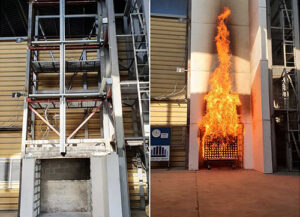
The purpose of the test is to provide data to enable evaluation of the fire performance of the components when combined to form a complete cladding system. This part of BS 8414 does not apply to non-loadbearing external rainscreen over cladding systems or external wall insulation systems applied to the face of a building, the fire testing of which is covered in BS 8414-1. This part of BS 8414 does not cover the performance of the glass or its supporting frame intended for glazed window openings. This part of BS 8414 does not apply to glazed curtain walling systems. This part of BS 8414 does not test the total configuration of construction incorporating additional windows, doors, balconies, or ancillary penetrations. This part of BS 8414 does not cover exposure to radiant heat from a fire in an adjacent building”.
BS 8414 does not stipulate pass/fail criteria within the standard. Report BR 135 (Fire Performance of External Thermal Insulation for Walls of Multistorey Buildings) and BS 9414 (Fire performance of external cladding systems – The application of results from BS 8414-1 and BS 8414-2 tests), first issued in September 2019, can be used to evaluate the results of the test for practical applications.
How Is BS 8414 Referenced In The UAE FLS Code?
The UAE Fire and Life Safety (FLS) code use this test method in two ways:
- Setting minimum compliance requirements for the use of specific materials to be used as key façade elements. This is done using a combination of small-scale material tests validating the individual reaction to fire properties of components, and the BS 8414 test method along with BR135 evaluation criteria to create evidence validating a defined design configuration. A proven design philosophy also adds to learning for designers and subcontractors of what combinations of materials and design elements can achieve the requirements.
- To evaluate the specific cladding design of a particular project. As many architects and façade designers work hard to differentiate the look for a building, many different combinations of designs and materials are created. The UAE FLS Code calls for additional test evidence if the designs and materials being proposed are not part of a certified and listed system (a Certified and Listed system is one which is detailed on the website of a Certification Body who audits one or more component manufacturer’s factories as part of their Certification). In such cases, a project-specific mock-up is tested as per one of the referenced fire propagation tests (like the BS 8414).
Parenthetically, Glass Fiber Reinforced Concrete (GFRC or GRC) has an interesting difference from other types of cladding in the way it is treated in the FLS code. The code allows any of these four large scale fire propagation tests for all cladding types except GFRC/GRC: NFPA 285 or BS 8414 or FM 4880 or ISO 13785-2. For GFRC/GRC only three test methods are acceptable: BS 8414, FM 4880, or ISO 13785-2. NFPA 285 is not acceptable for GFRC/GRC.
History And Revision
The test method was developed to evaluate the behaviour of a cladding system when a fire breaks out of an opening (such as a window). When this occurs there is a potential for the fire to spread via the cladding and also to re-enter the building in another compartmentalised area. The full-scale test is necessary because the smaller scale tests on individual materials don’t evaluate design elements such as joints, fixings, termination details, insulation, fire barriers, cavities, etc., and neither do they consider how the presence or reaction of one material might affect the response of an adjacent one.
As new materials and designs surface, previously unknown risks are discovered. This is why standards must constantly evolve and update. Major fire incidents are an obvious catalyst for such reviews. BS 8414 was first issued in 2002 and was initially revised in 2015. The new revision, 2020, contains significant changes, as we shall see.
Height And A New Level
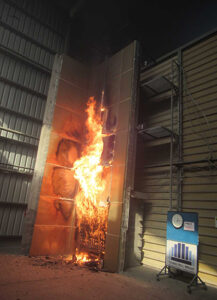
As mentioned above, BS 8414 does not have any specific performance criteria – specifiers and jurisdictions are free to choose classification standards or their own classification criteria. BR 135 referenced in the UAE FLS code. Originally and up to the current revision, the test apparatus (for both BS 8414-1 and BS 8414- 2) had a height of 8 meters and had two levels of thermo couples (temperature sensors) for observation and references. Now the height has been increased by 1.7 m and added a new level of thermo couples. Provision for an early termination of the test has been introduced using a reference line which is at the new level of thermo couples. In prior versions, the test could be terminated if the flame extended above the test apparatus. The additional height and new thermo couples in the third level provide greater insights when evaluating performance according to BR 135 or BS 9414.
Improved Accuracy
Wind speed will always influence the flame propagation in an external cladding fire. With improved accuracy of the wind monitoring equipment from ±0.5m/s (1.8 km/hr) to ±0.1m/s, the variation in test results while considering repeatability and reproducibility is expected to reduce substantially. It may be noted that high winds are a significant element in many of the worst cladding fires, however, the difficulty of reproducing such conditions reliably in a laboratory setting means that essentially still conditions are the only option. It will also be noted that this requirement virtually excludes conducting the BS 8414 test outdoors.
Masonry Blocks
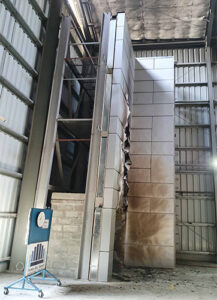
BS 8414-1 applies to the situation where the cladding is supported by a masonry substrate in the test apparatus – as opposed to a steel frame where BS 8414-2 applies. The new revision now defines the masonry substrate more precisely. Where previously the masonry blocks were specified to have minimum values for compressive strength, density and thermal conductivity, and many types of masonry blocks exceeded these requirements, now the stated values are ‘nominal’ values which are only met by a type of lightweight, thermally efficient blocks manufactured by a small number of firms in the UK. This aims to reduce any potential influence of the substrate on the results making the test more harmonized – i.e. the results should be more reliably replicated in different laboratories.
Defining Damaged Area
The physical damage on the cladding system due to fire is an important parameter. The earlier version of standard speaks about recording post-test observations but was never keen on quantifying the damaged areas. The new standard made it mandatory to include the percent of the damaged area in the post-test observation. This provides additional data than can be used while designing the fire and life safety strategy of a given building.
Using New Knowledge
There are over a dozen large scale fire tests published to evaluate the fire propagation behaviour of Cladding Designs. Though the intent of all these tests is same, to provide criteria for cladding systems and materials that minimise the risk of a fire that spreads through the cladding (either outside or between the cladding and the building) and engulfs large parts of the building with the consequent loss of life and property for the occupants – they all approach the task differently.
While many of these fire safety tests conduct a test on a flat face, the BS 8414 test apparatus has an L-shaped design in the form of a corner with a long wall and a shorter one. While most, if not all tests simulate fire exiting the building via a window opening, there are also differences in the fire itself. Gas is used in the North American test (NFPA 285) and heptane is used in the Swedish test (SP105); BS 8414 utilises a timber ‘crib’ consisting of layers of soft-wood ‘sticks’ where the wood alternates with spaces of the same size and the layers alternate in the direction of the sticks. It produces a massive amount of energy.
The UAE FLS code offers a choice of the test standards as described above. Chapter (18) of the code, on Roles and Responsibilities, passes the choice of test standard to stakeholders closest to assessing the risk, rather than a one-size fits- all approach. As the leader in the testing and certification of building elements related to Passive Fire Protection in a wide region centered on Dubai, Thomas Bell-Wright International Consultants provides both BS 8414-1 and BS 8414-2 as well as a large range of resistance-to-fire, reaction-to fire, other fire propagation, product certification, building envelope testing and façade consulting in their large Dubai facility. The company celebrated its 25th anniversary this year.

Co-Author :
Sujana Haridas is a post-graduate in Civil Engineering (specialised in Soil Mechanics). Before joining Thomas Bell- Wright International Consultants, she was an integral part of the teaching faculty in a leading Institute of Technology in India, where she also led the Concrete Technology & Strength of Materials Lab.
Over the course of the past 2 years, she has conducted over 400 Reaction-to-Fire safety tests across British, American & European standards. The wide array of products that she has tested has led her to develop a keen understanding of material behaviour in a fire scenario. She is currently handling fire propagation tests on large-scale façade mock-ups in the Fire Testing Laboratory here in Dubai.
